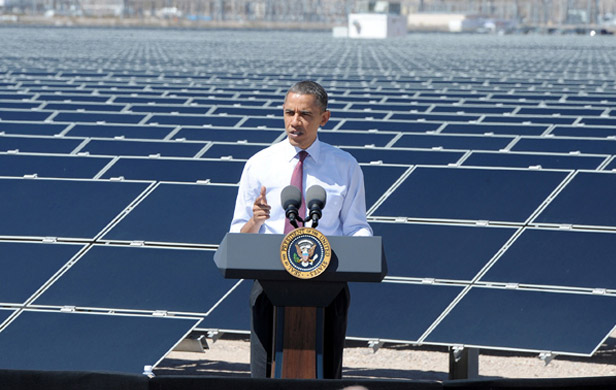
By Dina Cappiello, The Associated Press
WASHINGTON – The Environmental Protection Agency on Monday rolled out a plan to cut carbon dioxide emissions from power plants by 30 per cent by 2030, setting the first national limits on the chief gas linked to global warming.
The rule, expected to be final next year, is a centerpiece of President Barack Obama’s plans to reduce the pollution linked to global warming, a step that the administration hopes will get other countries to act when negotiations on a new international treaty resume next year.
Despite concluding in 2009 that greenhouse gases endanger human health and welfare, a finding that triggered their regulation under the 1970 Clean Air Act, it has taken years for the administration to take on the nation’s fleet of power plants. In December 2010, the Obama administration announced a “modest pace” for setting greenhouse gas standards for power plants, setting a May 2012 deadline.
Power plants are largest source of greenhouse gases
Obama put them on the fast track last summer when he announced his climate action plan and a renewed commitment to climate change after the issue went dormant during his re-election campaign.
Said Frances Beinecke, president of the Natural Resources Defence Council, which has drafted a plan that informed the EPA proposal:
[quote]The purpose of this rule is to really close the loophole on carbon pollution, reduce emissions as we’ve done with lead, arsenic and mercury and improve the health of the American people and unleash a new economic opportunity.[/quote]
Power plants are the largest source of greenhouse gases in the U.S., accounting for about a third of the annual emissions that make the U.S. the second largest contributor to global warming on the planet.
New rule tough on coal
Yet the rule carries significant political and legal risks, by further diminishing coal’s role in producing U.S. electricity and offering options for pollution reductions far afield from the power plant, such as increased efficiency. Once the dominant source of energy in the U.S., coal now supplies just under 40 per cent of the nation’s electricity, as it has been replaced by booming supplies of natural gas and renewable sources such as wind and solar.
“Today’s proposal from the EPA could singlehandedly eliminate this competitive advantage by removing reliable and abundant sources of energy from our nation’s energy mix,” Jay Timmons, president and CEO of the National Association of Manufacturers, said in a statement issued Sunday.
Partisan battle ahead
The White House said Obama called a group of Democrats from both the House and Senate on Sunday to thank them for their support in advance of the rule’s official release, which is expected to be rigorously attacked by Republicans and make Democrats up for re-election in energy-producing states nervous.
EPA data shows that the nation’s power plants have reduced carbon dioxide emissions by nearly 13 per cent since 2005, or about halfway to the goal the administration will set Monday. The agency is aiming to have about 26 per cent cut by 2020.
But with coal-fired power plants already beleaguered by cheap natural gas prices and other environmental regulations, experts said getting there won’t be easy. The EPA is expected to offer a range of options to states to meet targets that will be based on where they get their electricity and how much carbon dioxide they emit in the process.
Plan contains range of flexible solutions
While some states will be allowed to emit more and others less, overall the reduction will be 30 per cent nationwide.
The options include making power plants more efficient, reducing the frequency at which coal-fired power plants supply power to the grid, and investing in more renewable, low-carbon sources of energy. In addition, states could enhance programs aimed at reducing demand by making households and businesses more energy-efficient. Each of those categories will have a separate target tailor-made for each state.
Obama has already tackled the emissions from the nation’s cars and trucks, announcing rules to reduce carbon dioxide emissions by doubling fuel economy. That standard will reduce carbon dioxide by more than 2 billion tons over the life of vehicles made in model years 2012-25. The power plant proposal will prevent about 430 million tons of carbon dioxide from reaching the atmosphere, based on the 30 per cent figure and what power plants have already reduced since 2005.
The EPA refused to confirm the details of the proposal Sunday. People familiar with the proposal shared the details on condition of anonymity, since they have not been officially released.
Beinecke spoke Sunday on ABC’s “This Week,” before details of the proposal became public.
The proposal was first reported Sunday by The Wall Street Journal.
__
Associated Press writer Josh Lederman contributed to this report.


One wonders how the coal industry “lobbyists” are trying to work this to their favour……….
Hmmmmm, Coal producing States( Kentucky, Montana, etc) have marched out the senators already.
“This law will kill 800,000 jobs!” wailed one senator.
Stay tuned.
This is going to get ugly.